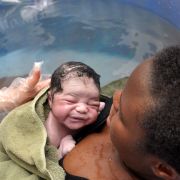What is it? Group B Streptococcus (GBS) is a bacterium that can be carried in the genital, urinary, digestive, and respiratory tracts. Up to one third of all adults carry GBS in their intestines, and one in four women carry it in their vaginas. Frequently, those who are carriers are asymptomatic (without symptoms) so often they do not realize that they are colonized. However, during pregnancy, birth and the postpartum period, GBS can cause serious problems for a small number of moms and babies.
What effect does it have? Prenatally, women with GBS have a higher incidence of urinary tract infections, premature rupture of the amniotic membrane (bag of water) and chorioamnionitis (infection of the amniotic membrane). Although urinary tract infections can be treated with antibiotics or alternative therapies, infection or rupture of the amniotic sack can cause premature birth or even fetal death. Babies born to GBS negative moms can also become infected, though they have a much lower infection rate. The overall GBS neonatal infection rate is only 0.18% (1.8/1000 live births). GBS is the most common cause of sepsis (blood infection), pneumonia and meningitis (infection of the fluid and lining surrounding the brain and central nervous system) in the newborn. The rate of infection increases to 0.5% (5/1000 live births) for babies born to mothers who are known to be colonized with GBS but who are without symptoms, and up to 4% (40/1000) for babies born to mothers who are colonized and have symptoms. Most cases of neonatal GBS infections (75%) occur during the first week of life (early-onset), and most of these are apparent a few hours after birth. These occurrences can be directly attributed to exposure of the baby during birth to GBS colonization in the mother.
The remaining 25% develop after the first week of life (late-onset), and frequently cause meningitis. Only about half of the late-onset infections can be attributed to exposure to colonization of the mother, leaving the source of the other half unknown. The mortality (death) rate for the infected newborns is 5-20%, and babies that survive, particularly those with meningitis, may have longterm problems such as hearing or vision loss or learning disabilities. Postpartum, women with GBS have a higher incidence of endometritis (infection of the uterine lining) and puerperal sepsis (blood infection related to the birth).
How do I know if I have it? The normal medical guidelines consider you to be positive for GBS if you have ever tested positive in the past. The Centers for Disease Control recommend that a vaginal/rectal swab be taken between the 35th and 37th week of pregnancy and cultured to detect GBS. Being positive means you are colonized with GBS and have a higher risk of transmitting the GBS to your newborn, particularly if you have a fever during labor, if your membranes are ruptured for more than 18 hours before delivery, or if you have preterm (before 37 weeks) labor or rupture of membranes.
What can I do if I have it? The CDC recommends the administration of intravenous (or intramuscular) antibiotics such as Ampicillin, Amoxicillin or Erythromycin during labor. This is seen as being the most effective (although not 100% effective) in preventing newborn GBS. Oral antibiotics have also been used, but are not considered as effective. Keep in mind antibiotics also may pose a threat to mother or baby, and some reactions may be life threatening. Any decision to take antibiotics should include consideration of the risk factors associated with antibiotics, especially since women who are colonized with GBS but do not develop any symptoms are at a relatively low risk (0.5%) of delivering a baby with GBS disease, Statistically, 10% (100/1000) of people who receive antibiotics experience a mild allergic reaction (such as a rash), 0.01% (1/10,000) experience a mild anaphylactic reaction, and 0.001% (1/100,000) experience a severe anaphylactic reaction resulting in death. Although it is uncommon, an unborn baby can experience a severe reaction even if the mother’s reaction is not life threatening.
What other options do I have? Experiential data has shown several alternative treatments to be effective in combating GBS colonization thereby minimizing infant exposure. In addition, being as healthy as you can by having a good diet and strong immune system can also go a long way to keeping unwanted bacteria from becoming a problem. There are a number of things used to combat GBS naturally such as specific probiotics that fight GBS, herbal protocols including a special GBS negative herbal blend oral tincture and vaginal wash, garlic/echinacea combination and tea tree vaginal suppositories, etc. Remember because these are non-medical treatments, there is no statistical data to support their effectiveness. You may also have heard of a protocol using hlorohexidine (Hibicleanse) as a vaginal wash during labor. This surgical wash has proven effective against streptococcal bacteria in dental use, and has been used as a bactericide in obstetrics and surgery for many years. Some individuals experience a mild allergic reaction to chlorohexidine, usually in the form of a mild rash, but severe reactions are extremely rare, and no adverse effects to the newborn have been noted.
I hope you now understand the basics of GBS and that you do have options. Talk with your midwife or doctor about what is best for you.
For evidence-based midwifery carae in southwest Missouri, southeast Kansas or northeast Oklahoma call Emily Myers at 417-321-9035 to schedule a free interview.

Is a Home Birth right for you?
One of the main reasons people have traditionally chosen to give birth in hospitals—or haven’t questioned it—is the belief that hospitals are inherently safer. And for a time, that was true. However, today’s mothers are generally healthier, receive more comprehensive prenatal care, and benefit from higher living standards. On top of that, advancements in medical technology have transformed maternity care.
All of these factors have contributed to making planned home births just as safe—if not safer—for healthy women as hospital births. This has been consistently demonstrated by numerous studies conducted worldwide. More

When families begin exploring the option of home birth, they often encounter a flood of opinions—and unfortunately, plenty of misinformation. As a midwife, I’ve heard many of the same myths repeated over the years, and I’ve seen how those false ideas can create fear or hesitation around what can be a safe and beautiful way to welcome a baby.
Let’s take a closer look at some of these common myths—and the truth that sets the record straight.
Questions? Want to schedule an interview?
Feel free to call
417-321-9035
or click below and fill out a form to get more info.
© Crowned With Good Midwifery